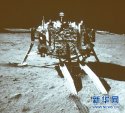plawolf
Lieutenant General
China's Chang'e-3 makes successful Moon landing
By Brian Dodson
December 14, 2013
Following 12 minutes of precise maneuvering which began in lunar orbit, China's Chang'e-3 lunar lander, with the Yu Tu (Jade Rabbit) lunar rover onboard, successfully landed on the Moon's surface at 13:11 UT Saturday night. At this point, Chang'e-3's solar panels were opened to begin charging the rover's batteries for its first drive about the lunar surface, which is expected to begin about seven hours after landing.
Chang'e-3 began its descent from the lowest part of its orbit, some 15 km (9 miles) above the Moon's surface. During its descent to an altitude of 2 km (1.2 mi), deceleration reduced the 1.71 km/s (1.06 mi/s) orbital velocity of the Chang'e-3 to zero. At 2 km altitude, the automatic landing sequence cut in, setting Chang'e-3 on course for its landing in Sinus Iridum (Sea of Rainbows) without further control from Earth.
At an altitude of 100 meters (330 ft), the Chang'e-3 began to hover over the surface, building a map of ground conditions and landing obstacles. Hovering was planned to last up to 100 seconds, but actually only took about 20 seconds.
A brief pause was taken at an altitude of 30 meters to further refine the approach. Once the landing site was chosen autonomously, Chang'e-3 slows edged down to an altitude of 4 meters, at which point the rocket was cut off, and the lander fell the rest of the way, landing on the surface with impact-absorbing legs.
China Central Television has now reported that the lander has deployed its solar panels, and has established X-band telemetry with Earth. The Jade Rabbit rover is being charged and initialized before it will be unlocked from its storage configuration during the flight. The rover will then establish its own separate data link with Earth, deploy its mast and panels, and moves onto its unloader, which lowers YuTu to the lunar surface, a process that will take several hours. At this point both the lander and rover will take panoramic images of their immediate surroundings before the rover begins local exploration.
Congratulations, China! It is about time someone went back to the Moon, and you did it in style. This video shows the soft landing from orbit to ground.
Amazing news, but why wasn't the batteries fully charged when Yutu was launched?




